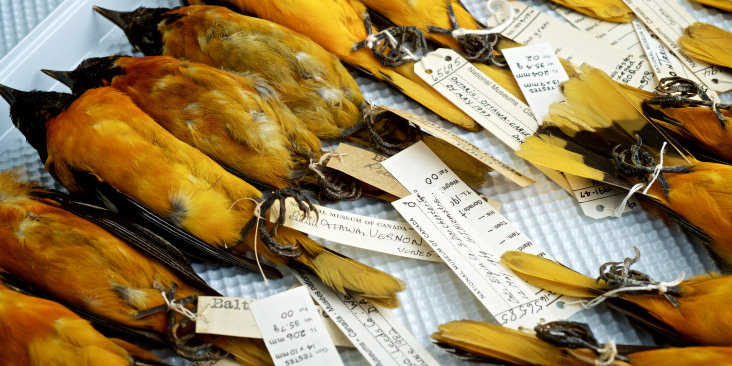- Home>
- Research & Collections>
- Collections>
- Zoology Collections
Martin Lipman © Canadian Museum of Nature
Close.Zoology Collections
Animals
The zoology collections are the most diverse and numerous of the national collection. The two main groups within the collections include the animals without a backbone (the invertebrates) and the animals with a backbone (the vertebrates).
Invertebrate Collections
The Canadian Museum of Nature's extensive Invertebrate Collections include specimens that date back to the mid-19th century. There are at least 1 928 960 lots, representing more than 7 118 870 specimens within collections of annelids, molluscs, crustaceans, insects, parasites and general invertebrates. In addition, zooplankton assemblages contain more than 11 241 940 mostly unsorted specimens.
Curator: Jean-Marc Gagnon.
Martin Lipman © Canadian Museum of Nature
Annelids
Our Annelid Collection provides a good representation of marine polychaetes, freshwater leeches and oligochaetes, with more than 439 230 specimens in about 64 500 lots, mostly from Canada, including the Arctic regions.
Molluscs
The museum's Mollusc Collection is the largest, most comprehensive collection of molluscs in Canada. The 1.73 million specimens in some 173 060 lots are divided into three sections: shell collection, wet collection and cephalopod collection. Overall, it represents more than 350 families, collected in over 12 countries and numerous oceans.
Crustaceans
Dating back to the 1800s, our Crustacean Collection contains specimens associated with the exploration and development of Canada. Gammaridea, Caprellidea, Isopoda, Hyperiidea and Mysidacea are the major groups found in the collection, which totals 1.6 million specimens in more than 175 800 lots.
Martin Lipman © Canadian Museum of Nature
Insects
Our Insect Collection houses more than 1 363 690 specimens, most being beetles. Scarabaeidae and Curculioniodea are particularly well represented. Geographic areas of representation include North, Central and South America, Australia and South Africa.
Parasites
Our Parasite Collection, which holds more than 85 350 specimens in 51 160 lots, contains large numbers of specimens from the Institute of Parasitology (McGill University) and the former Arctic Biological Station (Fisheries and Oceans Canada).
Invertebrates
The museum's General Invertebrate collection contains groups such as the cnidarians, various free-living helminths and non-segmented worms, and the echinoderms. Most of our 229 075 specimens in 46 750 lots of general invertebrates are from Canadian aquatic and terrestrial habitats, including the Canadian Arctic.
Faunal Assemblage
Our Faunal Assemblage Collection was established in 1982 to recognize the importance of preserving orphaned collections of unsorted plankton and benthos. At present, the collection contains 204 000 lots, with no less than 13 million unidentified specimens.
Vertebrate Collections
The Canadian Museum of Nature's Vertebrate Collections include fish, amphibians and reptiles, birds, mammals and an osteological reference collection.
Curator: Kamal Khidas.
Martin Lipman © Canadian Museum of Nature
Fish
Our Fish Collection contains more than 754 190 specimens in 63 655 lots of fluid-preserved specimens. We have about 1740 type specimens that are mainly paratypes. We have a good representation of freshwater and marine species, predominately from North American high latitudes. The museum holds the best Canadian Arctic and lamprey collection in the world.
Amphibians and Reptiles
Our Amphibian and Reptile Collection contains more than 251 470 specimens in 37 925 lots, most of which are fluid-preserved, with some skeletons, skins and mounted specimens. It also boasts a very good collection of dried frog skins mounted on sheets of paper, like plants; they offer a very good source of tissue for DNA extraction. Our emphasis is on geographic and life history variation of common species in Canada. Approximately 83% of the collection comprises Canadian specimens. This collection counts representatives from some 930 species in 67 families. One hundred and thirty-eight are type specimens, including two holotypes, among which one is a Canadian holotype and five are Canadian paratypes.
Birds
Our extensive Bird Collection comprises study skins, mounted specimens, skeletons, nests, eggs and some fluid-preserved specimens. In all, there are more than 128 420 specimens representing about 2600 species (a quarter of the world's species). This reference collection documents the extensive variation found in bird species across Canada, but also in countries where some of our birds spend the winter, such as Mexico or Brazil. The collection contains specimens taken over a long span of time, including species that are now extinct.
Martin Lipman © Canadian Museum of Nature
Mammals
Our Mammal Collection has more than 65 210 study skins, pelts, mounts and skeletons, from about 600 species. We have the most comprehensive collection of Canadian mammals, with extensive coverage of Arctic regions. Carnivores, ungulates, rodents and marine mammals are well represented. The museum also holds many cetacean tissue samples (both dry and fluid-preserved) that were collected in the North Atlantic during commercial whaling operations in the 1960s and early 1970s.
Destructive Sampling
Please read our guidelines: Standard Operating Procedure for Destructive Sampling (116 Kb PDF).
Search Our Collections
Online Database
Access data from the museum's collections: search, map results, and download data and images. Search our collections.
Browser Plug-Ins
In order to fully access some of the content on this page, you may need to download the following:









